Gaming Market Enters Post-COVID Decline As Gamers Return To Work And School
New data from market research firm NPD adds a financial angle to the recent trends. In the last quarter, US consumer spending on video games has dropped by $1.78 billion, a significant 13 percent chunk of the total $12.35 billion market. It's a big change from a time not that long ago when many businesses were closed and travel was seen as too dangerous—gaming was the only thing that kept some people sane.
This matches the latest news from Microsoft and Sony, which saw revenue from games dropping for the first time since the pandemic began. Microsoft says its hardware sales were down 11 percent year-over-year last quarter. Sony is still selling every PlayStation 5 it can manufacture, but its software sales fell by 26 percent in the previous quarter. Even Nintendo, which has seen huge success with the Switch since release, says it is seeing sales fall.
For the average gamer, this could be a good thing. The combination of high demand and supply chain disruptions made game consoles almost impossible to buy throughout 2020 and 2021. Conditions have eased only slightly in 2022 -- you'll still have to hunt for the Xbox Series X and PlayStation 5, but it won't take you quite as long, and aftermarket prices are now just a few hundred more than retail rather than double the price. Hey, that's progress!

The downturn could energize efforts to move gamers to subscription services. While sales of hardware and individual games are on the decline, subscription services are still flying high, according to CNBC. Microsoft says strong revenue from Xbox Game Pass helped cushion the blow, and Sony has just launched its revamped PS Plus service to tens of millions of subscribers. Both services include numerous games, online service, and even cloud streaming of select titles.

